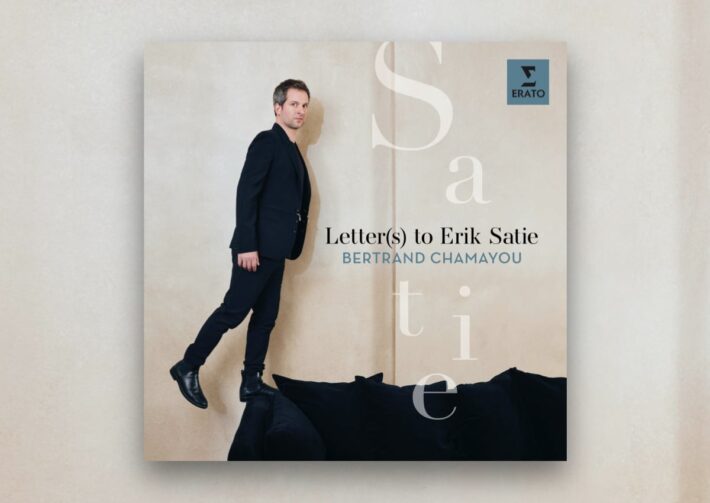Bertrand Chamayou seems to be taking a new direction with his recent solo recordings. We reviewed a compilation album, Good Night! (2020), and then the Vingt Regards by Messiaen (2022)—the latter which I especially enjoyed for its artistry. Now, he pairs Erik Satie with John Cage; this is an intriguing juxtaposition until we understand the relationship between the two composers, each an iconoclast of his time.
The programming speaks to how Cage regarded Satie as an inspiration. On the most obvious level is the opening homage, both by title and musical material: the left hand pattern is a direct nod to Satie’s Gymnopédie No. 1. The sparse texture lends itself naturally to a meditative feel, but Chamayou brings expressiveness to the static melody, too; listen to how well he maintains generous legatos, a silky sound quality, and continuity through the long lines. The corresponding Gymnopédie indeed makes an appearance (track 4) with similar interpretative finesse. If not shaped mindfully, the melody can become stodgy and metronomic, but the small ebbs push the melody forward in an uncontrived fashion. I also liked how the accompaniment has a character of its own with variation in dynamics, a sure sign of the responsiveness to Satie’s harmonic color changes.
One of the best studies in artistry on the album is Cage’s “In a Landscape” (track 8) that beautifully layers several elements. First are the chime-like motifs that appear mainly in the upper register to which Chamayou imbues a sparkling clarity; then, we have the meandering middle voice that, while minimalistic, is gorgeously mellow and unifies the entire work. Finally, there are the sympathetic resonances that form a cloud of sound that hovers above the melodic elements—the result of some fine pedal work.
To prevent the curation from becoming too atmospheric, Chamayou makes a sensible choice to include Satie’s 3 Véritable préludes flasques. The reprimand of the first prelude (track 11) could use a more biting articulation in my opinion, although the authoritative octaves do convey sternness. Seul à la Maison which follows has a rather interesting, if not off-kilter harmonic language that the pianist uses effectively to evoke a lurking disquietude. The abrupt changes between ferocious atonality and playful melodicism are what bring vitality to the final prelude; the humor in Chamayou’s playing has a sardonic air that for me complements Satie’s idiosyncratic musical lexicon.
Related Posts
- Review: Messiaen – Vingt Regards sur l’Enfant-Jésus – Bertrand Chamayou, Piano
- Double Review: Khatia Buniatishvili – “Labyrinth”, Bertrand Chamayou – “Good Night!”
- Review: “Proust, Le Concert Retrouvé” – Théotime Langlois De Swarte, Tanguy De Williencourt
On the note of idiosyncrasy is Cage’s Perpetual Tango (track 22) that takes its inspiration from Le Tango Perpétuel of Satie’s Sports et Divertissements. Where Satie’s work has the signature lilt of the dance, Cage makes some adjustments by omitting and lengthening certain beats. Chamayou’s meticulously even tone lets us focus on the rhythm, which feels distantly recognizable but, at the same time, distinctly different. Listen closely and we can also hear a subtle residual haze of sound, an eerie presence that adds dimensionality to the drier articulation.
Those hoping to hear Cage’s prepared piano works will not be disappointed, though the only regret about the Prelude for Meditation (track 3) is that it’s so short. We get a minute-and-some of a calming mysticism that transforms the piano from its conventional sound profile. A Room (track 7) goes one step further with a prepared ostinato only dotted with splotches of notes: Chamayou’s performance here brings out an almost primal side to the accompaniment, a rhythmic drumming of feet. The particular method of preparation gives the instrument a truly curious and almost otherworldly timbre.
With a program of many subtle works, the sound engineers had quite the challenge before them. I’m happy to say that they proved up for the task — I found mic placement and balance very satisfactory and conducive to bringing out all of Chamayou’s details in fingerwork and pedaling.
It’s always nice to see a pianist who starts with more mainstream repertoire, if you will, take on the challenge of creating more nuanced but meaningful programming. Chamayou’s inclusion of recognizable sets like Gymnopédies and Gnossiennes and the experimental Cage pieces keeps the performance fresh and insightful from start to finish. Likewise, his intelligent interpretations never left me feeling lost in esotericism or clichés. I very much look forward to hearing what he has planned next.

Latter(s) to Satie
Bertrand Chamayou – Piano
Warner Classics / Erato, 5054197696442
Recommended Comparisons
Erato Complete Works Box | Ciccolini | Thibaudet | Ogawa
Read more classical music reviews or visit The Classic Review Amazon store
Follow Us and Comment:
[wd_hustle id=”HustlePostEmbed” type=”embedded”]











